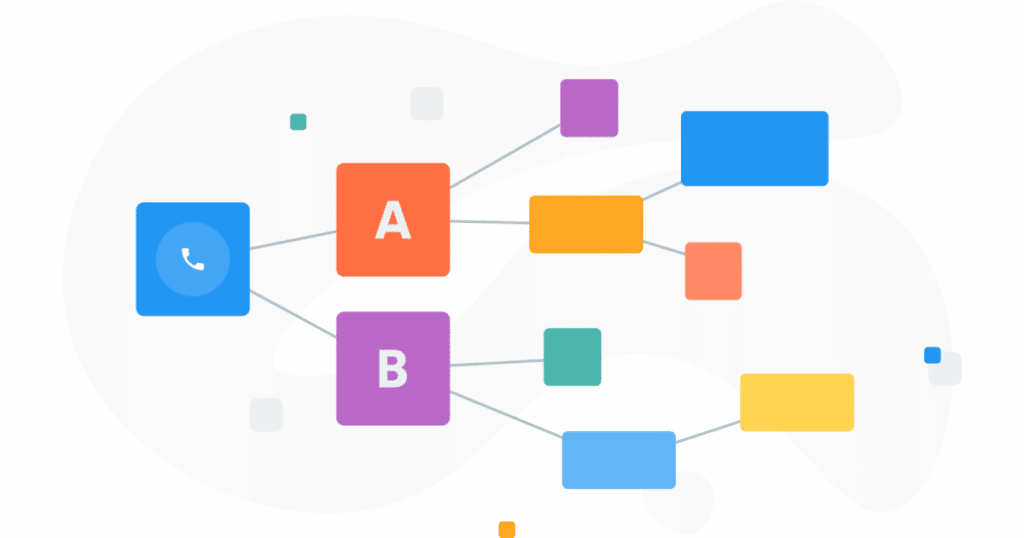Call Flows: importance, tips for effectivity

Everyone in the customer service industry knows that first impressions are crucial. Depending on how well the first contact with a customer goes, they may either stay loyal or start looking for another company right after the first, poor, customer service.experience. In fact, 24% of customers who have a good first impression are likely to remain loyal for up to 2 years.
Striving for exceptional customer service isn’t that easy, though. Agents’ workloads keep increasing and customers nowadays not only expect to be connected to an agent straight away, but they want to be connected to the right person for their needs and get their issue solved on the first call.
When on their own, customer support agents may struggle to meet all of those expectations. But here’s where an IVR system can come to the rescue. The main job of IVR is to direct all callers to the most suitable agent for a caller’s question or problem.Alternatively, it helps callers find answers for themselves via self-service options, thus saving a lot of agents’ time. But before it can start managing calls for you, you need to create IVR call flows that will tell the menu what to do.
Learn about the 5 best IVR solutions to test out
What is an IVR Call Flow?
Everyone who has ever used an IVR system is surely familiar with how it typically works. When reaching out to a business phone line, callers hear a pre-recorded greeting message that asks them to pick an option from the available choices. This is the famous “For sales, press 1” prompt.
Callers can select the desired option either by pressing a digit on their keypad or by giving a voice command to the IVR. Often, they are also asked to provide their data too, such as customer ID. Based on the input, the IVR menu will either connect the caller to a matching agent, answer a question, or ask them to leave a message for an agent.
This is precisely the IVR call flow or “phone tree”, a designed sequence of actions that allow an IVR menu to understand what a caller needs and show them the shortest route to achieving their goal. If everything is set up correctly and the call flow works smoothly, then the IVR can significantly benefit your customer service. Let’s look at the three biggest advantages.
Improved first call resolution rate
When a customer calls your support team, they want to get their question or issue solved as quickly as possible, preferably during the first contact. But what typically happens is that they have to talk to several agents and repeat their question each time.
However, with properly set up call flows leading to different departments, a caller can be quickly connected with the agent who has the skills or knowledge to answer the question and can solve the problem immediately. As the first call resolution rate is closely tied to a customer’s satisfaction or lack thereof, by solving your callers’ problems straight away, you can significantly boost both your satisfaction rate and your agents’ confidence.
Improved agent efficiency
A straightforward IVR call flow is also a massive timesaver for your agents. First, they know that only calls related to their skills and knowledge will be directed to them. That alone will save several precious minutes for them because they won’t have to spend time routing callers to other agents, time which they can spend taking care of other customers instead.
The second thing that can increase your agents’ efficiency is having access to customers’ data even before being connected to them. While callers are waiting for their turn, the IVR menu can ask them to input credentials such as customer ID, order number, or any other piece of necessary information. This means that when a call starts, the agent handling it will already have all the information they need to hand and can get straight to solving the issue rather than searching for the customer’s data or waiting for them to find their ID or order number, for example.
And as a bonus, the IVR system has several, built-in self-service options, through which callers can check their order status or schedule appointments themselves without an agent’s help. Freed from answering calls about business hours or other frequently asked questions, agents can instead focus on helping callers with more urgent or complicated matters.
Lower costs
Besides improving your customers’ satisfaction and taking some workload off your agents’ shoulders, an optimized IVR call flow can also lead to noticeable savings. The more time your callers spend on the line, the less time your agents have for other calls and the more you will pay for them.
By routing all callers to the right resources and helping them solve their problems faster, everyone can benefit. Your agents have more time to help other customers and thus are far more productive, while your customers are more likely to reach out to you in case they have a problem. Meanwhile, you will enjoy significant savings to your budget.
How to create a call flow that your callers will like?
So why is it that so many customers are annoyed by IVR menus and sometimes even prefer to be transferred between agents than use one?
Well, many IVR call flows are simply too long and confusing for callers. Before finding an option they need, the caller must listen to an endless array of menu options (with talk to a live agent being the very last one!).
Menus can be unnecessarily complicated, none of the options related to what callers need, and sometimes there’s not even an option to return to the previous menu!
No wonder then that frustrated customers hang up or ask for a live agent immediately. If you have already heard complaints about your company’s IVR menu or can see that several calls were ended while a caller was listening to it, that might mean your IVR call flow needs some tweaks. Here’s a couple of tips on how you can design a simpler and more user-friendly call flow.
- Put the most commonly picked options first – if callers have to listen to several irrelevant menu options before finding the one they need, there’s a good chance they will simply press “0” to be connected to a live agent instead. The prompts should be described in simple language to avoid misunderstandings that lead to the caller picking the wrong option.
- Keep the messages short – pre-recorded messages for callers shouldn’t be longer than 30 seconds, especially those played at the start of a call. Having to listen to overly long promotional messages when they want their issues to be resolved as soon as possible is a sure-fire way to irritate customers before they even reach a customer service agent. It would be best to leave any marketing messages for on-hold time, but still make sure they aren’t replayed over and over again.
- Always give your callers an option to speak to a live agent – while this increases the chance that they will take this opportunity straight away, burying it in your menu tree may be seen as trying to make reaching live support harder for callers instead of easier.
- Don’t rush your callers – for people unfamiliar with IVR or not exactly tech-savvy, pressing the right button or inputting their customer ID might take longer. Give them enough time to respond to the prompt.
- Provide your callers an option to return to the previous menu – it often happens that they press the wrong button or pick the incorrect choice. Giving callers an option to return to the previous or main menus will help them find their way back rather than abandon the call, as they might do if forced to end the call and phone back.
- Offer a callback option to your callers – if the waiting time in the queue is particularly long when a customer calls, it’s a good idea to suggest that they use the Callback feature. Thanks to this, a caller can leave their phone number in the IVR system for an agent to call them back when their turn comes without waiting on a busy line.
Conclusion
Just having an IVR menu in your company is not enough if you want to provide excellent customer support. A poorly designed IVR call flow can actually hurt customer satisfaction, whether that’s because the menu is too long and complicated or because callers have to keep listening to several messages while waiting for an agent to respond. And rather than help boost your agents’ productivity and confidence, this will only make them waste time on misrouted calls.
So, when designing or optimizing your IVR call flow, look at the options as your callers would. Is it easy to find your way around the menus, are the options easily accessible, and can customers find the information they need quickly? Once you know what your call flow should look like in order to be most helpful for your callers, CloudTalk’s Call Flow Designer can help you create an intelligent and seamless call flow that you can configure and optimize in just a few clicks. All that’s left after doing so is to reap the benefits of having an intelligent IVR helper in your company.
















